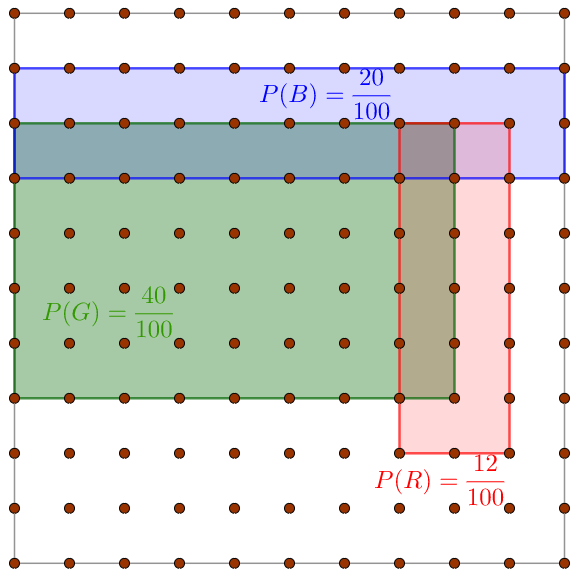Conditional Probability#
The probability of \(A\) occurring given that event \(B\) has already occurred is the conditional probability of \(A\) given \(B\):
In many conditional probability situations, we can solve for the required probability by restricting the probability space.
Example
A card is drawn at random from a standard deck of playing cards.What is the probability of drawing a heart (\(H\)) given that a red card (\(R\)) is drawn?
Solution. Half of the red cards are hearts.
We often can simply work with a new probability space - the red cards - rather than employing the formula. Yet, the formula works, too.
We use conditional probability to define independent probability events. The idea? If events \(A\) and \(B\) are independent, then \(B\) happening - or not - should not affect the likelihood of \(A\) happening.
Defintion. Let the event sets \(A\) and \(B\) be subsets of a probability space \(S\). Events \(A\) and \(B\) are said to be independent provided:
This implies that \(P(B)=P(B|A)\). To see that \(P(A)=P(A|B)\iff P(B)=P(B|A)\):
Example
Is drawing a face card (\(F\)) is independent of drawing a red card (\(R\))?
Solution. There are 12 face cards. Half the deck and half the face cards are red cards.
Since \(P(F|R)=\frac{3}{13}=P(F)\), the events are independent.
Example
At Riverside High School, the probability that a student takes Computer Programming and Spanish is 0.15. The probability that a student takes Computer Programming is 0.4. What is the probability that a student takes Spanish (\(S\)) given that the student is taking Computer Programming (\(C\))?
Solution. Note that \(P(S\cap C)= 0.15\) and \(P(C) = 0.4\).
The next example focuses on visualizing the relationship of the event sets when probabilities are independent.

Fig. 9 Conditional Probability Visualization#
Example
The events sets \(R,B,G\) are shown above as subsets of a probability space represented by a \(10\times 10\) grid. Determine if any of the event sets are independent given that \(P(G)=\frac{2}{5}\), \(P(B)=\frac{1}{5}\), and \(P(R)=\frac{3}{25}\).
Solution. Visually, notice that \(20\%\) of the green squares are also blue and that \(P(B)=20\%\). It appears that \(B\) and \(G\) are independent. Checking the other relationship visually, note that 8 of the 20 blue squares are also green (\(40\%\)), and that \(P(G)=40\%\).
We can also use the formulas.
The other two pairs of sets are not independent.

